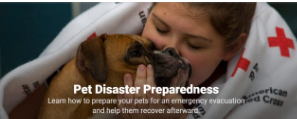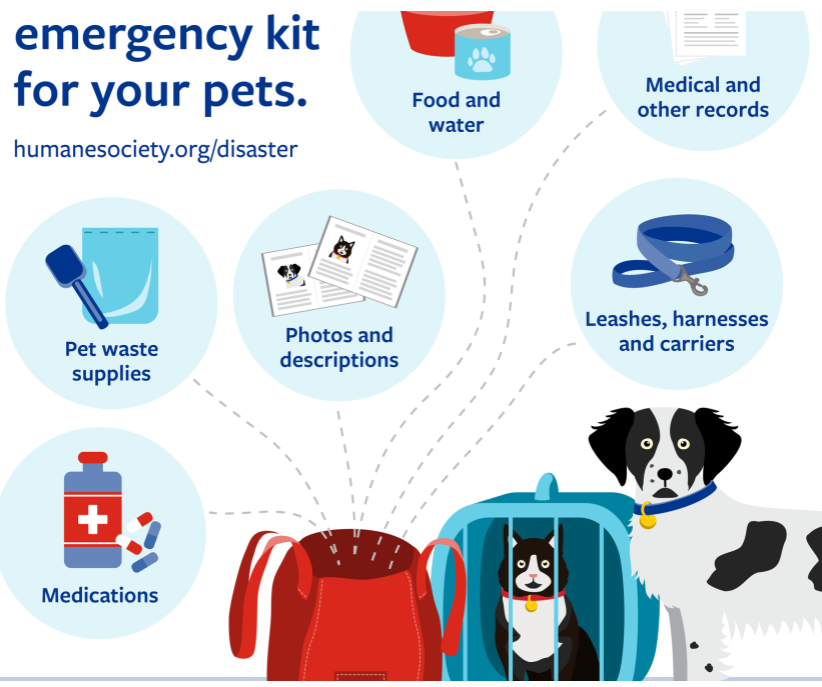Our pets safety is important. And emergencies come in many forms: fires, hurricanes, earthquakes, tornadoes, floods, violent storms and even terrorism. Equally important, In the event of extreme weather or a disaster. Would you know what to do to protect your pet? Leaving pets out of evacuation plans can put pets, pet owners, and first responders in danger. Even when you create a safe place for them. Pets left behind during a disaster are likely to be injured, lost, or worse. The CDC Pet Safety in Emergencies website. Encourage everyone with pets to be Be prepared: make a plan and prepare a disaster kit for your pet.
Before an Emergency

{ 1 }To start, familiarize yourself with the types of disasters. That could affect your area. Then consider your options for care for yourself an { 2 }Make sure your pet(s).Wear collars and tags with up-to-date contact information. Also other identification. Microchip your pet(s). This is one of the best ways. To ensure that you and your pet are reunited. If you are separated. { 3 } Register the microchip with the manufacturer. As well as Keep your contact information up to date. With the microchip company. { 4 }Keep a leash and/or carrier near the exit. Make sure you have proper equipment. For pets to ride in the car (carriers, harnesses, pet seatbelts). { 5 }Prepare a Pet Disaster Kit. Then evacuation will go smoothly for your entire family. Ask your veterinarian for help in putting together your pet’s veterinary records.
Make A Plan For Our Pets Safety
For our pets safety: Plan where you and your pet will stay in case you need to evacuate your home. Pets may not be allowed in local shelters, unless they are service animals. Many disaster evacuation centers (such as Red Cross evacuation centers) do not accept pets and other animals. Identify shelters or out-of-town friends or relatives where your pets and other animals can stay. Locate boarding facilities or animal hospitals near your evacuation shelter. And in the case you are unable to return home right away. Create a buddy system in case you’re not home during an emergency. Ask a trusted neighbor who can check on your animals and can evacuate your animals if necessary. Also, find a veterinarian or animal hospital in the area where you may be seeking temporary shelter. And add the veterinarian’s contact information to your emergency kit.
Create an emergency kit for your pet Safety

Prepare an emergency kit for your pet safety ahead of time. Kits should include. A pet carrier for each of your pets (write your pet’s name, your name, and contact information on each carrier). Food and water for at least 2 weeks for each pet. For cats: litter box and litter For dogs: plastic bags for poop. Medications for at least 2 weeks. Medical records, including record of vaccination for rabies and other diseases, prescription medications, and medical history. Sturdy leashes or harnesses. Microchip number. Contact information (cell phone, work phone, home phone) of owner and close relatives or friends.
Practice Evacuating Your Pet
Train your pets to get in and stay in their carriers to make it a comfortable place. Transport your pet take them for rides in the car . Both my Max [dog] and Smokey [Cat] love going out in the car. The problem is, if its a visit to the vet. When we get there ,yes you guess it, the fussing by both of them is unbelievable.
If you do not have a car, make arrangements with neighbors, family, and friends. For our pets safety, You can also contact your local government to learn about transportation options during a disaster. Know where your pet might hide when stressed or scared.
Practice catching your pet, if needed. For cats, you can practice removing your cat from its hiding spot. And using your cat’s carrier, a pillowcase, or a sturdy box. Anything to get your cat quickly out of harm’s way. And this is very Important. Have your entire family practice evacuating. Also with your pets so everyone knows what to take, where to find the pets, and where to meet.
During The Emergency
Sheltering during an evacuation
Remember, during a disaster, what is good for you is good for your pet. If you leave your pets behind, they may be lost, injured – or worse. Never leave a pet chained outdoors. Contact your local emergency management office and ask if they offer accommodations for owners and their pets. If you need accommodations for your pet(s). Contact local veterinary clinics. Boarding facilities, local animal shelters, family or friends outside the evacuation area, or a pet-friendly hotel, particularly along evacuation routes. Visit the Humane Society to find a shelter in your area. Remember to take your pet’s emergency kit with you. Learn what to expect if you take your pet to an evacuation center.
Sheltering in place
When sheltering at home with your pet. For their safety And Yours. Make sure the room chosen is pet-friendly Select a safe room, preferably an interior room with no (or few) windows. Remove any toxic chemicals or plants. Close off small areas where frightened cats could get stuck. In (such as Diseases that can spread between pets and people during a natural disaster
Diseases that can spread between pets and people during a natural disaster
Natural disasters can contribute to the spread of some diseases. Rabies, Leptospirosis. Diseases spread by mosquitoes, fleas, and ticks. Mosquitoes, fleas, and ticks are common pests of stray animals and can be a problem immediately after a disaster. Their bites irritate the skin and can also spread a variety of diseases. (Lyme disease, West Nile virus) harmful to both people and animals
How to Keep Yourself and Your Pets Healthy During a Disaster
Wash your hands after handling your pet, its food, or its waste (poop and pee).
Do not let your pet lick your face or hands.
Keep your pet up to date on all vaccinations and heartworm, flea, and tick preventives.
Practice safe handling of your pet because your pet may behave differently during a stressful situation.
Keep your pet in a carrier or on a leash.
Do not allow your pet to interact with other animals, especially wildlife and stray animals.
Report any bite wounds to medical personnel immediately.
Properly clean and disinfect cages and litterboxes. Wash your pet’s bedding regularly.
Avoid stagnant water, especially after flooding occurring after natural disasters.
Don’t allow pets to play in or drink contaminated water.
After an Emergency
After an emergency, familiar scents and landmarks may have changed. Pets can become confused and lost. So it’s important to keep pets on leash or in a carrier. When they’re being transported or when you go outside. Some hazards for pets and people include snakes and other wildlife, especially after flooding, and downed power lines.
Returning home
Check your home for sharp objects, spilled chemicals, and exposed wiring to protect your family and your pets from injury.
The behavior of animals may change dramatically after a flood, flash flood, thunderstorm, or hurricane. Normally quiet and friendly animals may become irritable.
Monitor animals closely and only release them in a safe and secure environment.
Contact a veterinarian if you notice any signs of stress, discomfort, or illness in your pets.
Resources From CDC
Pets in Evacuation Centers. Pet Project: 5 Ways to Prep Your Pet for Emergencies. Keep your pets safe in an emergency: 5 things to know. Pet Disaster Preparedness Kit Pet . Boarding Instructions [PDF – 2 pages]. Missing Pet Flyer Template [Doc – 1 page]. Interim Guidelines for Animal Health and Control of Disease Transmission in Pet Shelters. Ready Wrigley
In Conclusion
Returning home. Your pet’s behavior may change after a disaster. Even becoming aggressive or defensive. Be aware of their well being and protect them from hazards to ensure the safety of other people and animals. Watch your animals closely and keep them under your direct control as fences and gates may have been damaged. Talk to your veterinarian if you notice any signs of stress, discomfort, or illness in your pets. For more Information. Translations on this site now available in over 50 Languages. We are available to Contact with Regard to This site See How by CLICKING HERE



